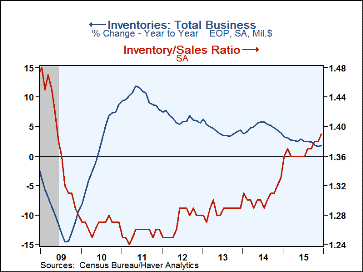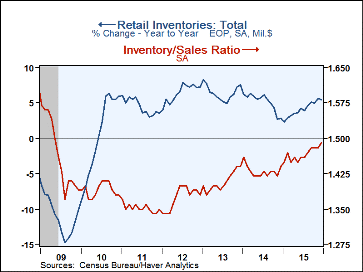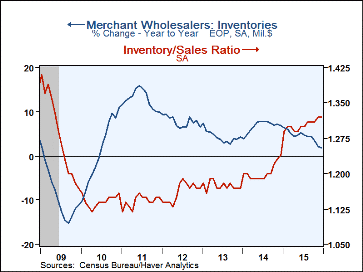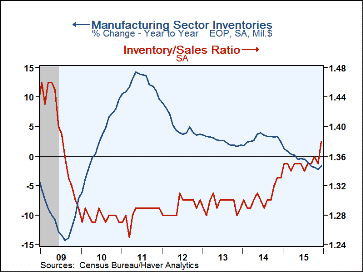 Global| Feb 12 2016
Global| Feb 12 2016U.S. Business Inventories Edge Up While Sales Slip in December
by:Sandy Batten
|in:Economy in Brief
Summary
Total business inventories edged up 0.1% m/m (1.7% y/y) in December, following a 0.1% m/m decline in both November and October. Total business sales fell 0.6% m/m (-2.7% y/y) in December for their third consecutive monthly decline. [...]
Total business inventories edged up 0.1% m/m (1.7% y/y) in December, following a 0.1% m/m decline in both November and October. Total business sales fell 0.6% m/m (-2.7% y/y) in December for their third consecutive monthly decline.
Retail inventories increased 0.4% m/m (5.4% y/y) on top of a 0.3% m/m gain in November. Motor vehicle & parts inventories jumped 0.9% (+7.3% y/y), the largest monthly change in the fourth quarter. Outside of the vehicle sector, retail inventories gained 0.2% (4.5% y/y) after two months of 0.3% increases. The new information in today's report was retail inventories. Including revisions, the retail inventory data was slightly softer than that assumed by the BEA in its first estimate of 4Q GDP. Consequently, they point, at least on the margin, to a small downward revision to the second estimate of the fourth quarter figures to be released on February 26.
Merchant wholesalers inventories eased 0.1% (+1.9% y/y) while the value of factory sector stockpiles rose 0.2% (-1.6% y/y), their first increase in six months.
The 0.6% m/m decline in business sales in December was led by a 1.4% m/m drop in manufacturing shipments (sales). Retail sales were unchanged in the month while wholesale sales slipped 0.3% m/m.
The business sector inventory-to-sales ratio rose to 1.39, its highest level since May 2009. The rise reflected a jump in the manufacturing sector to 1.38 from 1.35, its highest reading since July 2009 and a slight rise in the retail sector to 1.49 from 1.48, its highest level since May 2009. The merchant wholesale I/S ratio was unchanged at 1.32.
The manufacturing and trade data are in Haver's USECON database.
| Manufacturing & Trade (%) | Dec | Nov | Oct | Dec Y/Y | 2015 | 2014 | 2013 |
|---|---|---|---|---|---|---|---|
| Business Inventories | 0.1 | -0.1 | -0.1 | 1.7 | 1.7 | 3.9 | 4.3 |
| Retail | 0.4 | 0.3 | 0.1 | 5.4 | 5.4 | 2.8 | 7.6 |
| Retail excl. Motor Vehicles | 0.2 | 0.3 | 0.3 | 4.5 | 4.5 | 2.2 | 4.9 |
| Merchant Wholesalers | -0.1 | -0.4 | -0.3 | 1.9 | 1.8 | 6.7 | 4.1 |
| Manufacturing | 0.2 | -0.3 | -0.2 | -1.6 | -1.7 | 2.4 | 1.7 |
| Business Sales (%) | |||||||
| Total | -0.6 | -0.4 | -0.3 | -2.7 | -2.4 | 3.5 | 2.8 |
| Retail | 0.0 | 0.3 | -0.1 | 1.8 | 1.4 | 3.6 | 3.8 |
| Retail excl. Motor Vehicles | -0.1 | 0.2 | 0.0 | 0.4 | -3.3 | 2.6 | 2.6 |
| Merchant Wholesalers | -0.3 | -1.3 | -0.2 | -4.5 | -3.6 | 4.3 | 3.0 |
| Manufacturing | -1.4 | -0.1 | -0.7 | -4.7 | -4.3 | 2.6 | 1.9 |
| I/S Ratio | |||||||
| Total | 1.39 | 1.38 | 1.38 | 1.31 | 1.37 | 1.31 | 1.29 |
| Retail | 1.49 | 1.48 | 1.48 | 1.43 | 1.47 | 1.43 | 1.41 |
| Retail Excl. Motor Vehicles | 1.30 | 1.30 | 1.29 | 1.24 | 1.30 | 1.24 | 1.23 |
| Merchant Wholesalers | 1.32 | 1.32 | 1.31 | 1.22 | 1.30 | 1.20 | 1.18 |
| Manufacturing | 1.38 | 1.35 | 1.36 | 1.32 | 1.35 | 1.31 | 1.30 |
Sandy Batten
AuthorMore in Author Profile »Sandy Batten has more than 30 years of experience analyzing industrial economies and financial markets and a wide range of experience across the financial services sector, government, and academia. Before joining Haver Analytics, Sandy was a Vice President and Senior Economist at Citibank; Senior Credit Market Analyst at CDC Investment Management, Managing Director at Bear Stearns, and Executive Director at JPMorgan. In 2008, Sandy was named the most accurate US forecaster by the National Association for Business Economics. He is a member of the New York Forecasters Club, NABE, and the American Economic Association. Prior to his time in the financial services sector, Sandy was a Research Officer at the Federal Reserve Bank of St. Louis, Senior Staff Economist on the President’s Council of Economic Advisors, Deputy Assistant Secretary for Economic Policy at the US Treasury, and Economist at the International Monetary Fund. Sandy has taught economics at St. Louis University, Denison University, and Muskingun College. He has published numerous peer-reviewed articles in a wide range of academic publications. He has a B.A. in economics from the University of Richmond and a M.A. and Ph.D. in economics from The Ohio State University.










